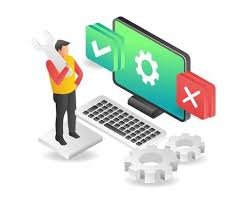
- Description
- Curriculum
- Grade
Personal Cybersecurity for Remote Workers
Course Overview
This course provides practical knowledge and skills to help remote workers protect themselves from cybersecurity threats. Participants will learn how to identify risks, use AI-driven tools to enhance security, and implement best practices for safeguarding personal and professional information.
—
Target Audience
– Remote workers and freelancers
– Small business owners and entrepreneurs
– Professionals working with sensitive or confidential information
– Anyone interested in improving personal cybersecurity practices
—
Learning Objectives
By the end of the course, participants will:
1. Understand the basics of cybersecurity and its importance in remote work.
2. Identify common cyber threats and learn strategies to mitigate them.
3. Use AI-driven tools to enhance security and streamline protective measures.
4. Implement secure practices for remote work environments, including device security and secure communications.
5. Develop a proactive cybersecurity mindset and incident response plan.
—
Course Format
– Duration: (self-paced or instructor-led)
– Delivery: Online video lectures, interactive simulations, readings, and assignments
– Tools: Cybersecurity software demos, AI security tools, and virtual labs
—
Course Curriculum
Module 1: Introduction to Cybersecurity for Remote Work
Topics Covered:
– Overview of cybersecurity threats for remote workers
– The importance of cybersecurity in a remote work environment
– Key terms: phishing, malware, ransomware, data breaches
– Activities:
– Cybersecurity risk self-assessment
– Interactive quiz: “How secure are your online habits?”
—
Module 2: AI-Driven Tools for Cybersecurity
– Topics Covered:
– AI for threat detection and prevention (e.g., antivirus software, firewalls)
– AI-powered password managers (e.g., LastPass, Dashlane)
– Machine learning in email filtering and anti-phishing tools
– Activities:
– Tool demo: Setting up and using an AI-powered password manager
– Assignment: Identify and evaluate AI-based security tools for personal use
—
Module 3: Securing Remote Work Devices and Networks
– Topics Covered:
– Best practices for device security (e.g., updates, encryption, antivirus)
– Setting up a secure home network (e.g., routers, firewalls, VPNs)
– The role of AI in securing devices and networks
– Activities:
– Virtual lab: Configuring a VPN and analyzing its security benefits
– Assignment: Conduct a security checkup on your personal devices
—
Module 4: Protecting Sensitive Data
– Topics Covered:
– Understanding data encryption and secure file sharing
– AI tools for secure document management (e.g., Microsoft Defender, Google Workspace security features)
– Avoiding data leaks and managing permissions
– Activities:
– Workshop: Encrypting and sharing a file securely
– Assignment: Create a secure document storage and sharing plan
—
Module 5: Cyber Threat Awareness and Response
– Topics Covered:
– Recognizing phishing and social engineering attempts
– AI-powered email filtering and threat detection tools
– Incident response: Steps to take after a data breach or cyberattack
– Activities:
– Simulation: Identify phishing attempts in a controlled email environment
– Group discussion: Share personal experiences and solutions to cyber threats
—
Module 6: Building a Long-Term Cybersecurity Strategy
– Topics Covered:
– Developing and maintaining a cybersecurity checklist
– Staying informed about emerging threats and AI advancements
– Integrating cybersecurity habits into daily routines
– Activities:
– Capstone project: Develop a personalized cybersecurity plan
– Reflection: How AI can help evolve cybersecurity strategies over time
—
Capstone Project
Title: Design Your Personal Cybersecurity Toolkit
– Description: Participants will create a customized plan that includes recommended AI tools, secure practices, and incident response strategies tailored to their specific needs and work environment.
– Submission: Written report or recorded presentation
—
Assessment and Certification**
– Certification: Participants scoring 70% or above will receive a “Certificate of Completion.”
—
Course Outcomes
Upon completing the course, participants will:
– Be equipped with the tools and knowledge to identify and prevent cyber threats.
– Have a tailored cybersecurity plan to safeguard their remote work setup.
– Be confident in using AI tools to enhance their cybersecurity practices.
-
1CurriculumText lesson
-
2Module 1: Introduction to Cybersecurity for Remote WorkText lesson
-
3Cybersecurity risk self-assessmentVideo lesson
-
4Quiz 120 questions
-
5Module 2: AI-Driven Tools for CybersecurityText lesson
-
6Setting up and using an AI-powered password managerVideo lesson
-
7Quiz 220 questions
-
8Module 3: Securing Remote Work Devices and NetworksText lesson
-
9Configuring a VPN and analyzing its security benefitsVideo lesson
-
10Quiz 320 questions
-
11Module 4: Protecting Sensitive DataText lesson
-
12Encrypting and sharing a file securelyVideo lesson
-
13Quiz 420 questions
-
14Module 5: Cyber Threat Awareness and ResponseText lesson
-
15Identify phishing attempts in a controlled email environmentVideo lesson
-
16Quiz 520 questions
-
17Module 6: Building a Long-Term Cybersecurity StrategyText lesson
-
18Develop a personalized cybersecurity planVideo lesson
-
19Quiz 620 questions
-
20Final Assessment (20 Questions)Text lesson






